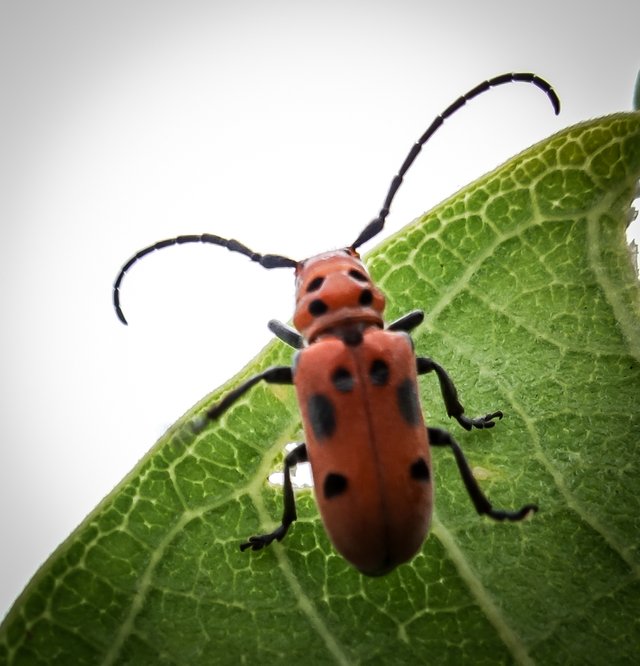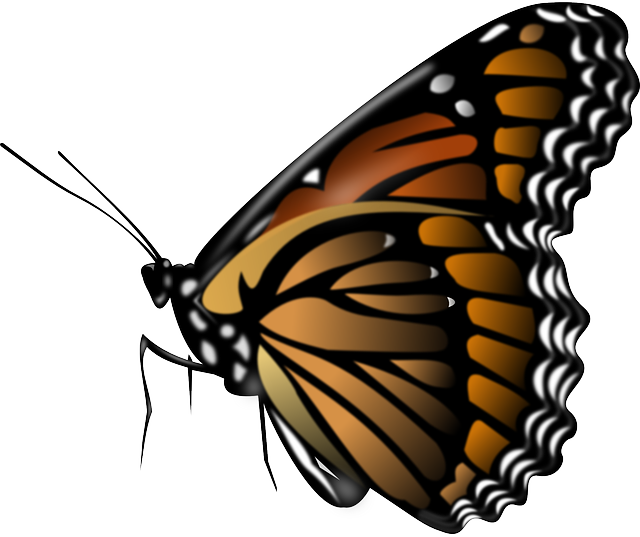Nature Flash #4 - The Red Milkweed Beetle

So this colorful beetle must be one of the competitors of the monarch butterflies, a bright red and black insect called the red milkweed beetle.

In a recent post entitled Nature Flash #1 - Monarchs Need Milkweed I shared some details about the plight of the monarch butterfly in North America, due in large part to the noticeable disappearance of the milkweed plant in the last twenty or thirty years.
The monarchs rely heavily on milkweed as a source for food and breeding and, apparently, so does this red milkweed beetle.

If you break off a milkweed leaf it immediately starts oozing a bright white milky latex that contains alkaloids and other complex compounds. I read that when the young monarch butterflies feed on this creamy concoction, the white liquid is emitted so fast that it pours out like a fire-hose and can often kill them. Think what would happen if you tried to drink from a fire-hose!
Another interesting fact is that the toxins in the milkweed are ingested by the monarchs, and if a bird eats one of these butterflies it will often vomit them out and likely avoid eating them in the future.

To me, the red milkweed beetle kind of looks like a super-sized, tricked-out version of a lady bug that had one too many botox injections!
And after attempting to photograph these red milkweed beetles in the oppressive heat and humidiy this afternoon, I can tell you that they can see you and they are very quick to avoid you by either flying away or quickly maneuvering to the opposite side of the leaf that they are perched on.
Scientifically named tetraopes tetrophthalmus, Wikipedia notes the following about the red milkweed beetle:
The milkweed beetle, a herbivore, is given this name because they are generally host specific to milkweed plants (genus Asclepias). It is thought the beetle and its early instars derive a measure of protection from predators by incorporating toxins from the plant into their bodies, thereby becoming distasteful, much as the monarch butterfly and its larvae do. The red and black coloring are aposematic, advertising the beetles' inedibility. There are many milkweed-eating species of insect that use the toxins contained in the plant as a chemical defense.
On a side-note, one thing I learned today is that my Sony RX100 V is mediocre in terms of macro capability. I wish it were better or, rather, I wish I was better at coaxing it to take closer captures.
Oh well, something else to add to my constantly growing "to-be-mastered" list!
Follow me @cognoscere












Al images (except as noted) @cognoscere and taken on Thursday 07/13/2017 at Thompson Park in Lincroft, New Jersey (Sony RX100 V)

You always have a great story to go with your amazing pics. Thanks for taking the time to share it with us! Steem On @cognoscere!
Cool beetles. Nice post,
That is so much great @cognoscere
You have a great sense of sharing information with us a certain way, I love it ! Thanks my friend
Great shots @cognoscere. So now my question is - what is happening to the milkweed beetle now that milkweed is in low supply? Is our whole food chain damned?
great pics and must say very nice info
GOOD SHOOT MY FRIEND
Great read and even though not true macro photography some excellent shots! I like the one where the beetle is at the top of the plant with his antennas up. Keep up the good work!
They do look like punk rock ladybugs with ape hanger handlebar antennas!! Great pics to go with a great story .... thanks for posting @cognoscere
Thanks for the great post and reminder of the milkweed plant. Haven't seen one since I moved out of the Midwest, and they were a large part of our 'habitat' growing up. Fun to mess with, but we never realized they were possibly toxic. Maybe not to a bunch of little kids, who knows. Thanks for taking me back, and the info on the camera shy bug on steroids.